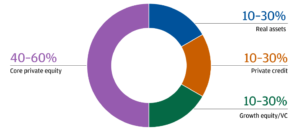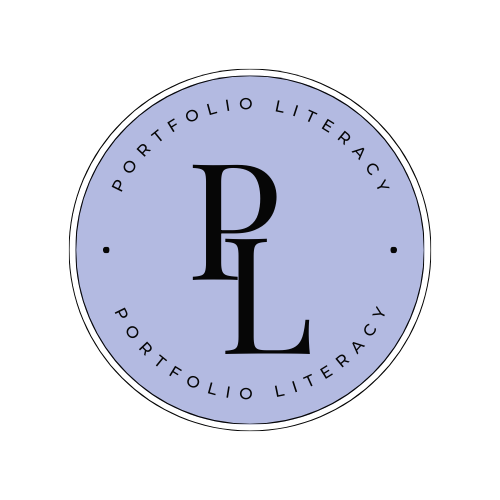We previously covered JP Morgan’s analysis of family office portfolios, and they showed that on average, the wealthiest families invest 50% of their entire portfolio in alternative assets. So many aspire to build their wealth to be like these families, having tens or even hundreds of millions of dollars in assets, but wonder how they build the alternative asset portion of the portfolio.
Creating a well-balanced alternative asset portfolio can offer high returns and help protect your wealth, but it requires careful planning and risk assessment. It’s crucial to consider your financial goals, risk tolerance, and investment timeline. Remember, alternative assets often come with unique risks and less liquidity than traditional investments.
This post can be just as informative for those with a portfolio less than $50M, however if you are still on your way to building wealth, we recommend reading about what we call the “poor man’s alternative assets” to build your net worth.
Return Structure of Alternative Assets
Alternative assets offer unique ways to grow and protect wealth. They differ from public market assets like stocks and bonds, yet they can have similar return structures that can incentivize matching classic portfolio models like the 60/40 allocation, which we will get into later.
Private Equity
Private equity typically offers a return structure that is more complex and potentially higher than public equity, but it also carries greater risk and less liquidity. In private equity, returns often come from a combination of capital appreciation through business growth and operational improvements, as well as exit events like acquisitions or IPOs. Investors generally expect higher returns to compensate for the illiquidity and longer investment horizons, anywhere from 2-10 years. Similarly, public equity returns are driven by stock price appreciation and dividends, and the investments are more liquid, allowing for quicker entry and exit. However, public equity tends to be more influenced by market volatility and short-term investor sentiment.
Alternative Assets for Income
Alternative assets for income investing, such as private credit, real estate, or infrastructure, often provide higher yields compared to publicly traded bonds due to their increased risk and illiquidity. These assets generate steady cash flows, similar to bond interest payments, but with the potential for higher returns through higher rates of return. These investments require longer holding periods and carry additional risk, like credit risk or market shifts, that can affect income stability, of which are priced into the yield. In comparison, publicly traded bonds offer lower yields but greater liquidity, more predictable income streams, and generally lower risk, making them a more conservative choice for income-focused investors.
Crafting a Portfolio with Alternative Assets
Building a diverse portfolio with alternative assets requires careful planning and consideration. Key factors to keep in mind when creating an investment strategy include investment objective, time horizon, and risk tolerance.
Determining Investment Objectives
When crafting your portfolio, you first need to define clear investment objectives.
Some common investment objectives include:
- Capital preservation
- Income generation
- Long-term growth
- Inflation protection
It is important to align your asset allocation, with the goals that are important to you. For example, if you are seeking income, you might include real estate investments that generate rental income. If growth is your priority, you may consider private equity or venture capital opportunities.
Assessing Risk Tolerance and Time Horizon
Your risk tolerance and investment timeline play vital roles in shaping your alternative asset portfolio because when you need the expected capital is significant, as these assets are not easily sold, and you will not be able to change your mind easily on this matter.
Risk tolerance refers to how much volatility you can comfortably handle. Alternative investments often come with higher risks, so you need to be honest about your risk appetite when making investments in the private market.
Time horizon is the length of time you plan to hold your investments. Many alternative assets are illiquid and require long-term commitments.
You should consider:
- Your age and retirement plans
- Financial goals and when you need to access funds
- Your ability to weather market ups and downs both financially and psychologically
These factors will help you decide which alternative assets fit with your personal circumstances.
Importance of Asset Allocation for Alternatives
A portfolio of alternative assets should be thought about similarly to a portfolio of public market assets, with considerations for return profiles and liquidity.
An illustration from JP Morgan Private Bank shows different considerations investors have when building their portfolio of alternative assets.

The exact percentages depend on your goals and risk tolerance, as the above image is for illustrative purposes only. A gradual allocation to alternative assets is often wise due to their illiquid nature. It is common to ladder investment exits with alternatives similar to laddering bonds, so that maturing capital will always be available. It is another form of diversification that can help reduce the risk in your portfolio.
Challenges and Considerations with Alternative Assets
Alternative investments can be complex and come with unique risks. It’s crucial to understand their potential drawbacks before adding them to your portfolio.
Liquidity Concerns and Fees
One of the biggest challenges with alternative investments is their lack of liquidity. Many alternatives require long-term commitments, even sometimes up to 10 years. This means you can’t easily access the money if needed.
Higher fees are another concern. Alternative asset managers can often charge:
- Management fees (1-2% annually)
- Performance fees (10-20% of profits over a hurdle rate)
- Other miscellaneous fees
These costs can significantly eat into your returns over time. These fees are comparable to publicly traded ETFs and their expense ratio, however there is less transparency around where your money ultimately gets invested in. It is incredibly important that you carefully weigh the potential benefits of these higher expenses before investing in alternatives.
Regulatory Hurdles and Tax Implications
Alternative investments face less regulation than traditional assets. This can lead to:
- Limited transparency
- Potential conflicts of interest
- Increased risk of fraud
Tax implications can be complex. Always consult a tax advisor before investing. Some alternative investments may have taxable events that:
- Generate taxable income even without distributions
- Require filing additional tax forms
- Have different tax treatment than traditional investments
Rounding Out Your Portfolio with Alternatives Assets
Structuring a portfolio of alternative assets over $50M requires careful consideration of personal financial goals, risk tolerance, and liquidity needs. While some investors may prioritize steady income through private credit or real estate, others may focus on long-term growth via private equity or venture capital. The ideal mix of alternative assets will vary for each family or individual, balancing diversification, returns, and risk management. Ultimately, the key to success is aligning your alternative asset strategy with your overall financial objectives, ensuring that your portfolio not only grows but also supports your unique long-term vision.
If you are at the +$50M level of wealth, we highly recommend you work with a team of financial professionals who can manage and assist with your specific goals. This post is meant for information purposes only and is not financial advice for your specific situation.
Disclaimer:
This post contains mentions of a company or companies that invest and manage money for others. This post is not a recommendation to use, abstain from, or do business with said companies. Portfolio Literacy is unaffiliated with said companies and receives no compensation for mentioning them.
